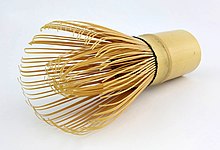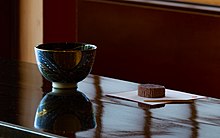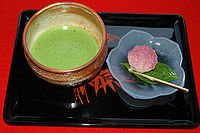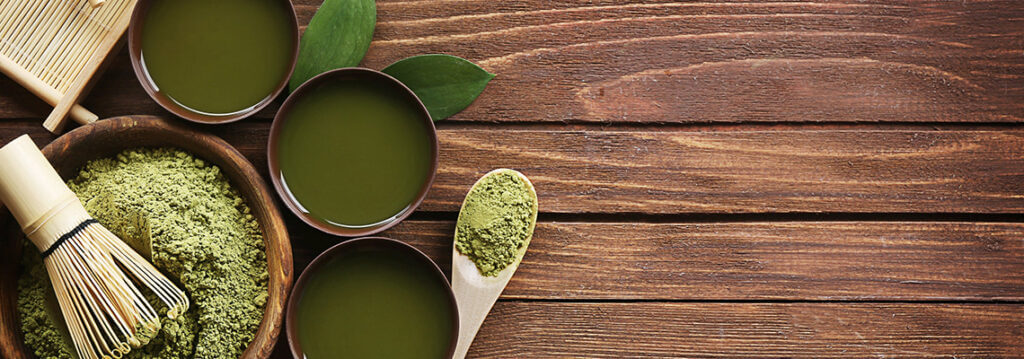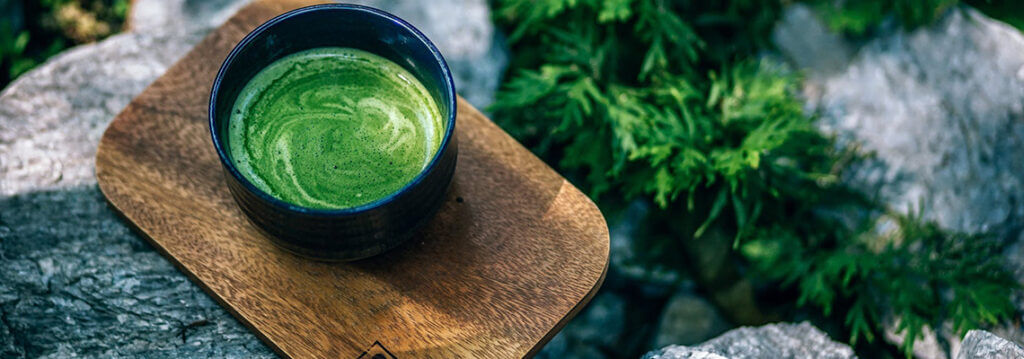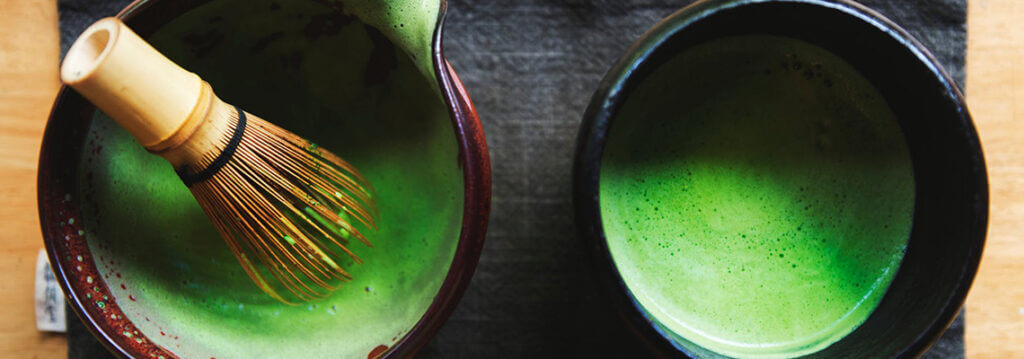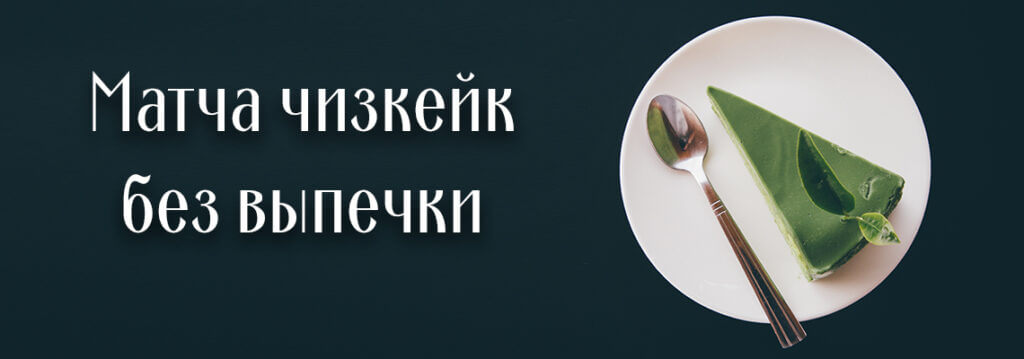| Matcha | |
|---|---|
 |
|
| Type | Green tea |
|
|
|
| Other names | 抹茶, «fine powder tea», maccha or macha |
| Origin | China |
|
|
|
| Quick description | Stone-ground Chinese-style green tea |
|
|
| Regional names | |||||||||||
|---|---|---|---|---|---|---|---|---|---|---|---|
«Matcha» in kanji |
|||||||||||
| Chinese name | |||||||||||
| Chinese | 抹茶 | ||||||||||
|
|||||||||||
| Korean name | |||||||||||
| Hangul | 말차 | ||||||||||
| Hanja | 抹茶 | ||||||||||
|
|||||||||||
| Alternative Korean name | |||||||||||
| Hangul | 가루차 | ||||||||||
|
|||||||||||
| Japanese name | |||||||||||
| Kanji | 抹茶 | ||||||||||
| Kana | まっちゃ | ||||||||||
|
Matcha[a] (抹茶, English: ;[1][2] Japanese: [mattɕa]; Mandarin: [mwò.ʈʂʰǎ]; pinyin: mǒchá; Korean: 말차; RR: malcha) is finely ground powder of specially grown and processed green tea leaves, traditionally consumed in East Asia. The green tea plants used for matcha are shade-grown for three to four weeks before harvest; the stems and veins are removed during processing. During shaded growth, the plant Camellia sinensis produces more theanine and caffeine. The powdered form of matcha is consumed differently from tea leaves or tea bags, as it is suspended in a liquid, typically water or milk.
The traditional Japanese tea ceremony centers on the preparation, serving and drinking of matcha as hot tea, and embodies a meditative spirituality. In modern times, matcha is also used to flavor and dye foods, such as mochi and soba noodles, green tea ice cream, matcha lattes and a variety of Japanese wagashi confectionery.
Matcha used in ceremonies is referred to as ceremonial-grade, meaning that the powder is of a high enough quality to be used in the tea ceremony. Lower-quality matcha is referred to as culinary-grade, but no standard industry definition or requirements exist for matcha.
Blends of matcha are given poetic names known as chamei («tea names») either by the producing plantation, shop, or creator of the blend, or by the grand master of a particular tea tradition. When a blend is named by the grand master of a tea ceremony lineage, it becomes known as the master’s konomi.
History[edit]
In China during the Tang dynasty (618–907), tea leaves were steamed and formed into tea bricks for storage and trade. The tea was prepared by roasting and pulverizing the tea, decocting the resulting tea powder in hot water, and then adding salt.[3] During the Song dynasty (960–1279), the method of making powdered tea from steam-prepared dried tea leaves and preparing the beverage by whipping the tea powder and hot water together in a bowl became popular.[4]
Preparation and consumption of powdered tea was formed into a ritual by Chan Buddhists. The earliest extant Chan monastic code, titled Chanyuan Qinggui (Rules of Purity for the Chan Monastery, 1103), describes in detail the etiquette for tea ceremonies.[4][5][better source needed]
Zen Buddhism and methods of preparing powdered tea were brought to Japan by Eisai in 1191. In Japan, it became an important item at Zen monasteries, and from the 14th through the 16th centuries, it was highly appreciated by members of the upper echelons of society.
Production[edit]
Iced tencha tea, brewed from the leaves used to make powdered matcha
Matcha is made from shade-grown tea leaves that also are used to make gyokuro. The preparation of matcha starts several weeks before harvest and may last up to 20 days, when the tea bushes are covered to prevent direct sunlight.[citation needed] This slows down growth, stimulates an increase in chlorophyll levels, turns the leaves a darker shade of green, and causes the production of amino acids, in particular theanine. After harvesting, if the leaves are rolled up before drying as in the production of sencha (煎茶), the result will be gyokuro (jade dew) tea. If the leaves are laid out flat to dry, however, they will crumble somewhat and become known as tencha (碾茶). Then, tencha may be deveined, destemmed, and stone-ground to the fine, bright green, talc-like powder known as matcha.[citation needed]
Grinding the leaves is a slow process because the mill stones must not get too warm, lest the aroma of the leaves be altered. Up to one hour may be needed to grind 30 grams of matcha.[citation needed]
The flavour of matcha is dominated by its amino acids.[6] The highest grades of matcha have a more intense sweetness and deeper flavour than the standard or coarser grades of tea harvested later in the year.[citation needed]
Tencha[edit]
Tencha refers to green tea leaves that have not yet been ground into fine powder as matcha, as the leaves are instead left to dry rather than be kneaded. Since the leaves’ cell walls are still intact, brewing tencha tea results in a pale green brew, which has a more mellow taste compared to other green tea extracts, and only the highest grade of tencha leaves can brew to its fullest flavor. Tencha leaves are half the weight of other tea leaves such as sencha and gyokuro so most tencha brews require double the number of leaves. About an hour is needed to grind 40 to 70 g of tencha leaves into matcha, and matcha does not retain its freshness as long as tencha in powder form because powder begins to oxidize. Drinking and brewing tencha is traditionally prohibited by the Japanese tea ceremony.[7]
Grades[edit]
Commercial considerations, especially outside Japan, have increasingly seen matcha marketed according to «grades», indicating quality.
Of the following terms «ceremonial grade» is not recognised in Japan but «food grade» or «culinary grade» are.
- Ceremonial grade designates tea for its use in tea ceremonies and Buddhist temples. All must be able to be used in koicha (濃茶), a «thick tea» with a high proportion of powder to water used in traditional tea ceremony.
- Premium grade is high-quality matcha green tea that contains young tea leaves from the top of the tea plant. Best for daily consumption, it is characterized by a fresh, subtle flavor, usually perfect for both new and everyday matcha drinkers alike.
- Cooking/culinary grade is the cheapest of all. Suitable for cooking purposes, smoothies etc. It is slightly bitter due to factors such as its production from leaves lower down on the tea plant, terroir, the time of harvest, or the process of its manufacture.
In general, matcha is expensive compared to other forms of green tea, although its price depends on its quality. Higher grades are pricier due to the production methods and younger leaves used, and thus they have a more delicate flavour, and are more suited to be enjoyed as tea.
Like other forms of green tea, all grades of matcha have the potential health benefits and risks associated with the Camellia sinensis plant (the human clinical evidence is still limited), while the nutrient content varies depending on climate, season, horticultural practices, plant variety, manufacturing methods and the age of the leaf, i.e., the position of the leaf on the harvested shoot. Catechin concentration is highly dependent on leaf age (the leaf bud and the first leaf are richest in epigallocatechin gallate), but catechin levels also vary greatly between plant varieties and whether the plants are grown in shade.[8][9][10][11]
Chemical compositions of various grades of matcha were studied, with the results showing that the contents of caffeine, free amino acids, theanine, and vitamin C decreased with the decreasing price of matcha.[12]
Another study examined the chemical components of tencha (from which matcha is made), and showed that higher grade teas contained greater amounts of total amino acids, theanine, and other individual amino acids. On the other hand, the high grade teas contained lower amounts of total catechins than lower grade teas (epigallocatechin (EGC) and epicatechin (EC) contents were greater in lower grade teas, while those of epigallocatechin gallate (EGCG) and epicatechin gallate (ECG) did not seem to correlate with tea grade), with the conclusion that the EGCG/EGC ratio reflected the quality of matcha more effectively than the EGC or total catechin contents. The relationship between the grade of tencha and caffeine contents seemed low. The chlorophyll contents were greater in the higher grade teas with a few exceptions, likely related to the strong shading used to cultivate high quality tencha.[11]
The study also examined the chemical components of ceremonial grade matcha, industrial grade matcha (referring to powdered teas used in the food industry and cooking, and labelled matcha), and other powdered green tea samples (like sencha and gyokuro). The prices of industrial matcha were >600 Yen/100 g, and the prices of ceremonial matcha were >3,000 Yen/100 g. On the other hand, prices of powdered green tea were <600 Yen/100 g. The prices ranged from 8,100 Yen/100 g (ceremonial grade) to 170 Yen/100 g (powdered sencha). Samples of matcha for tea ceremonies were characterized by high contents of theanine (>1.8 g/100 g), and high ratios of EGCG/EGC (>3.2 g/100 g). On the other hand, for the industrial grade matcha samples and powdered green teas, the theanine contents and EGCG/EGC ratios were <1.7 g/100 g and <3.3 g/100 g, respectively. The contents of chlorophyll of matcha for tea ceremonies were >250 mg/100 g, and of most of the other samples were <260 mg/100 g. Although no difference was found between the theanine contents and EGCG/EGC ratios of industrial grade matcha and powdered green teas, the chlorophyll contents in industrial grade matcha tended to be higher than those of powdered green tea.[11]
Location on the tea bush[edit]
Where leaves destined for tencha are picked on the tea bush is vital for different grades of matcha. The young developing leaves on the top of the plant, that are soft and supple, are used for higher grades of matcha, resulting in a finer texture and flavour. For the lower grades, older more developed leaves are used, giving them a sandy texture and slightly bitter flavour.
Treatment before processing[edit]
Traditionally, sencha leaves are dried outside in the shade and are never exposed to direct sunlight; however, now drying has mostly moved indoors. Quality matcha is vibrantly green as a result of this treatment.[13]
Stone grinding[edit]
Without the correct equipment and technique, matcha can become «burnt» and suffer degraded quality. Typically, in Japan, it is stone-ground to a fine powder through the use of specially designed granite stone mills.[13]
Oxidation[edit]
Oxidation is also a factor in determining grade. Matcha exposed to oxygen may easily become compromised. Oxidized matcha has a distinctive hay-like smell, and a dull brownish-green colour.
Traditional preparation[edit]
The two main ways of preparing matcha are thin (薄茶, usucha) and the less common thick (濃茶, koicha).
Prior to use, the matcha is often forced through a sieve to break up clumps. Special sieves are available for this purpose, which are usually stainless steel and combine a fine wire-mesh sieve and a temporary storage container. A special wooden spatula is used to force the tea through the sieve, or a small, smooth stone may be placed on top of the sieve and the device shaken gently.
If the sieved matcha is to be served at a Japanese tea ceremony, then it will be placed into a small tea caddy known as a chaki. Otherwise, it can be scooped directly from the sieve into a chawan.
About 2–4 grams of matcha is placed into the bowl, traditionally using a bamboo scoop called a chashaku, and then about 60–80 ml of hot water are added.[citation needed]
A chasen is used to create a uniform consistency
While other fine Japanese teas such as gyokuro are prepared using water cooled as low as 40 °C, in Japan, matcha is commonly prepared with water just below the boiling point[14] although temperatures as low as 70–85 °C or 158–185 °F are similarly recommended.[15]
Usucha, or thin tea, is prepared with about 1.75 g (amounting to 1+1⁄2 heaped chashaku scoop, or about half a teaspoon) of matcha and about 75 ml (2+1⁄2 US fl oz) of hot water per serving, which can be whisked to produce froth or not, according to the drinker’s preference (or to the traditions of the particular school of tea). Usucha creates a lighter and slightly more bitter tea.[citation needed]
Koicha, or thick tea, requires significantly more matcha (usually about doubling the powder and halving the water): about 3.75 g (amounting to 3 heaped chashaku scoops, or about one teaspoon) of matcha and 40 ml (1.3 fl oz) of hot water per serving, or as many as 6 teaspoons to 3⁄4 cups of water. Because the resulting mixture is significantly thicker (with a similar consistency to liquid honey), blending it requires a slower, stirring motion that does not produce foam. Koicha is normally made with more expensive matcha from older tea trees (exceeding 30 years), thus producing a milder and sweeter tea than usucha. It is served almost exclusively as part of Japanese tea ceremonies.[citation needed]
The mixture of water and tea powder is whisked to a uniform consistency using a bamboo whisk known as a chasen. No lumps should be left in the liquid, and no ground tea should remain on the sides of the bowl. Because matcha may be bitter, it is traditionally served with a small wagashi sweet[16][better source needed] (intended to be consumed before drinking), but without added milk or sugar. It is usually considered that 40 g of matcha provides for 20 bowls of usucha or 10 bowls of koicha:[17]
Other uses[edit]
It is used in castella, manjū, and monaka; as a topping for shaved ice (kakigōri); mixed with milk and sugar as a drink; and mixed with salt and used to flavour tempura in a mixture known as matcha-jio. It is also used as flavouring in many Western-style chocolates, candy, and desserts, such as cakes and pastries, including Swiss rolls and cheesecake, cookies, pudding, mousse, and green tea ice cream. Matcha frozen yogurt is sold in shops and can be made at home using Greek yogurt. The Japanese snacks Pocky and Kit Kats have matcha-flavoured versions.[18] It may also be mixed into other forms of tea. For example, it is added to genmaicha to form matcha-iri genmaicha (literally, roasted brown rice and green tea with added matcha).
The use of matcha in modern drinks has also spread to North American cafés, such as Starbucks, which introduced «green tea lattes» and other matcha-flavoured drinks after they became successful in their Japanese store locations. As in Japan, it has become integrated into lattes, iced drinks, milkshakes, and smoothies.[citation needed]
-
Matcha ice cream at a restaurant in Tokyo
-
Matcha cake
-
-
Basic matcha teaware[edit]
The equipment required for the making of matcha is:
- Tea bowl (茶碗, chawan)
- Large enough to whisk the fine powder tea around 120 millilitres (4 US fl oz)
- Tea whisk (茶筅, chasen)
- A bamboo whisk with fine bristles to whisk or whip the tea foam
- Tea spoon (茶杓, chashaku, also called tea scoop)
- A bamboo spoon to measure the powder tea into the tea bowl (not the same as a Western teaspoon)
- Tea caddy (棗, natsume)
- A container for the matcha powder tea
- Tea cloth (茶巾, chakin)
- A small cotton cloth for cleaning teaware during the tea ceremony
Health effects[edit]
As matcha is a concentrated form of green tea, it has been reputed by enthusiasts for centuries that matcha possesses stronger health benefits associated with green tea. Caffeine is more concentrated in matcha, but the main matcha constituent expected to have a stress-reducing effect is theanine. Theanine is the most abundant amino acid in green tea, and together with succinic acid, gallic acid and theogallin is what gives matcha its umami flavor.[19][20] Compared to traditional green tea, the production of matcha requires the tea leaves to be protected from sunlight. Shading results in an increase in caffeine, total free amino acids, including theanine, but also reduces the accumulation of flavonoids (catechins) in leaves.[11][19]
Skeletal model of theanine molecule
Theanine’s stress-reducing effects were tested at Japan’s University of Shizuoka, School of Pharmaceutical Sciences, where studies show that laboratory mice that consumed more than 33 mg/kg of matcha had significantly suppressed adrenal hypertrophy, a symptom that shows sensitivity to stress. The School of Pharmaceutical Sciences also tested the stress-reducing effects on university students and confirmed that students who ingested 3 grams of matcha in 500 ml of room-temperature water had reduced anxiety (State-Trait Anxiety Inventory or STAI), than students who consumed placebo.[21]
See also[edit]
- Green tea
- Food powder
Notes[edit]
- ^ «Matcha», also called fine powder tea or powdered tea, is the most common spelling, and accords with Hepburn romanization of the hiragana まっちゃ. In Kunrei-shiki romanization (ISO 3602) it is «mattya». «Maccha» is a nonstandard and uncommon spelling.
References[edit]
- ^ «matcha – Definition of matcha in English by Oxford Dictionaries». Oxford Dictionaries – English. Archived from the original on 4 September 2017. Retrieved 9 September 2017.
- ^ «matcha». Merriam-Webster Dictionary. Retrieved 22 January 2021.
- ^ Han Wei, «Tang Dynasty Tea Utensils and Tea Culture: Recent Discoveries at Famen Temple», in Chanoyu Quarterly no. 74 (1993)
- ^ a b Tsutsui Hiroichi, «Tea-drinking Customs in Japan», paper in Seminar Papers: The 4th International Tea Culture Festival. Korean Tea Culture Association, 1996.
- ^ «thezensite: The Origins of Buddhist Monastic Codes in China; book review». thezensite. Archived from the original on 23 February 2009. Retrieved 11 March 2009.
- ^ Kaneko, Shu; Kumazawa, Kenji; Masuda, Hideki; Henze, Andrea; Hofmann, Thomas (March 2006). «Molecular and Sensory Studies on the Umami Taste of Japanese Green Tea». J. Agric. Food Chem. 54 (7): 2688–2694. doi:10.1021/jf0525232. PMID 16569062.
- ^ «Tencha – Pure Elegant Flavor». hibiki-an.com. Retrieved 7 February 2021.
- ^ Chacko, Sabu M.; Thambi, Priya T.; Kuttan, Ramadasan; Nishigaki, Ikuo (6 April 2010). «Beneficial effects of green tea: A literature review». Chinese Medicine. 5: 13. doi:10.1186/1749-8546-5-13. PMC 2855614. PMID 20370896.
- ^ Koch, Wojciech; Kukula-Koch, Wirginia; Komsta, Łukasz; Marzec, Zbigniew; Szwerc, Wojciech; Głowniak, Kazimierz (11 July 2018). «Green Tea Quality Evaluation Based on Its Catechins and Metals Composition in Combination with Chemometric Analysis». Molecules. 23 (7): 1689. doi:10.3390/molecules23071689. PMC 6100455. PMID 29997337.
- ^ Graham, Harold N. (May 1992). «Green tea composition, consumption, and polyphenol chemistry». Preventive Medicine. 21 (3): 334–350. doi:10.1016/0091-7435(92)90041-F. PMID 1614995.
- ^ a b c d Horie, Hideki (20 October 2017). «Chemical Components of Matcha and Powdered Green Tea». Journal of Cookery Science of Japan. 50 (5): 182–188. doi:10.11402/cookeryscience.50.182.
- ^ Ikegaya, Kenjiro; Takayanagi, Hirotsugu; Anan, Toyomasa (1 December 1984). «Chemical composition of Mat-cha». Chagyo Kenkyu Hokoku (Tea Research Journal). 1984 (60): 79–81. doi:10.5979/cha.1984.60_79.
- ^ a b «Growing and Processing of Matcha». Marukyu-Koyamaen. Archived from the original on 30 April 2016. Retrieved 18 April 2016.
- ^ «How to enjoy Matcha (powdered green tea) with ease». kyoto-teramachi.or.jp. Retrieved 11 November 2020.
- ^ «Preparation of Matcha». Marukyu-Koyamaen. Archived from the original on 2 November 2011. Retrieved 7 November 2011.
- ^ Hosking, Richard (1997). «Wagashi». A Dictionary of Japanese Food. Tuttle Publishing. p. 168.
- ^ Horaido. «H4». JP: Dion. Archived from the original on 6 April 2005.
Matcha used to be sold in packages of 10 monme (ancient measure of about 3.75 g, or 37.5 g for the package) and most tea masters considered that one package provided for 20 usucha (about 1.8 g each) or 10 koicha (about 3.75 g each). This is why today’s traditional packaging is 40 g (the closest to 10 monme)
- ^ Rebecca Smithers (24 February 2019). «The matcha moment: why even KitKats now taste of green tea». The Guardian.
- ^ a b Ashihara, Hiroshi (1 May 2015). «Occurrence, biosynthesis and metabolism of theanine (γ-glutamyl-L-ethylamide) in plants: a comprehensive review». Natural Product Communications. 10 (5): 803–810. doi:10.1177/1934578X1501000525. PMID 26058162. S2CID 6069179.
- ^ Kaneko, S.; Kumazawa, K.; Masuda, H.; Henze, A.; Hofmann, T. (5 April 2006). «Molecular and sensory studies on the umami taste of Japanese green tea». Journal of Agricultural and Food Chemistry. 54 (7): 2688–94. doi:10.1021/jf0525232. PMID 16569062.
- ^ Unno, Keiko (10 October 2018). «Stress-Reducing Function of Matcha Green Tea in Animal Experiments and Clinical Trials». Nutrients. 10 (10): 1468. doi:10.3390/nu10101468. PMC 6213777. PMID 30308973.
External links[edit]
Media related to Matcha at Wikimedia Commons
English[edit]
Alternative forms[edit]
- maccha
Etymology[edit]
Borrowed from Japanese 抹茶 (matcha), from 抹 (matsu, “to wipe, to rub”) + 茶 (cha, “tea”).
Pronunciation[edit]
- (UK) IPA(key): /ˈmæ.tʃə/
- (US) IPA(key): /ˈmɑ.t͡ʃə/
- Rhymes: -ætʃə, -ɑːtʃə
Noun[edit]
matcha (countable and uncountable, plural matchas)
- A type of powdered green tea, traditionally used in Japanese tea ceremonies.
[edit]
- amacha
Translations[edit]
powdered green tea for ceremonies
- Arabic: مَاتْشَا f (mātšā)
- Hijazi Arabic: ماتشا f (mātša)
- Azerbaijani: matça
- Bengali: মাচা (maca)
- Chinese:
- Mandarin: 抹茶 (zh) (mǒchá)
- Finnish: matcha (fi)
- French: matcha (fr) m
- German: Matcha m
- Greek: μάτσα (el) n (mátsa)
- Gujarati: માચા (mācā), દળચા (daḷcā)
- Hebrew: מָאצָ׳ה m (máchah)
- Hungarian: matcsa, matcha
- Italian: matcha m, maccha m
- Japanese: 抹茶 (ja) (まっちゃ, matcha), 挽き茶 (ひきちゃ, hikicha), 散茶 (さんちゃ, sancha)
- Korean: 말차 (malcha), 가루차 (garucha)
- Polish: matcha (pl) f
- Portuguese: matchá
- Russian: ма́ття f (máttja)
- Serbo-Croatian:
- Cyrillic: маћа f, мача f
- Roman: maća (sh) f, mača (sh) f
- Turkish: toz yeşil çay (tr), yeşil çay tozu (tr)
- Ukrainian: ма́ття f (máttja), ма́ча (uk) f (máča), ма́тча f (mátča)
- Vietnamese: mạt trà
See also[edit]
- chanoyu
- sencha
- tea whisk
Further reading[edit]
matcha on Wikipedia.Wikipedia
French[edit]
Etymology[edit]
Borrowed from Japanese 抹茶 (matcha), from 抹 (matsu, “to wipe, to rub”) + 茶 (cha, “tea”).
Pronunciation[edit]
- IPA(key): /mat.ʃa/
- Rhymes: -a
Noun[edit]
matcha m (uncountable)
- matcha (powdered green tea for ceremonies)
Anagrams[edit]
- mâchât
Garo[edit]
Etymology[edit]
From Proto-Bodo-Garo *mV⁴-sha (“tiger”).
Pronunciation[edit]
- IPA(key): /matt͡ɕa/
Noun[edit]
matcha
- tiger
Italian[edit]
Alternative forms[edit]
- maccha
Etymology[edit]
Borrowed from Japanese 抹茶 (matcha), from 抹 (matsu, “to wipe, to rub”) + 茶 (cha, “tea”).
Pronunciation[edit]
- IPA(key): /ˈmat.t͡ʃa/
- Rhymes: -attʃa
- Hyphenation: màt‧cha
Noun[edit]
matcha m (uncountable)
- matcha (powdered green tea for ceremonies)
Japanese[edit]
Romanization[edit]
matcha
- Rōmaji transcription of まっちゃ
Norwegian Bokmål[edit]
Alternative forms[edit]
- matchet
Verb[edit]
matcha
- inflection of matche:
- simple past
- past participle
Swedish[edit]
Etymology 1[edit]
1952: borrowed from English match, from Middle English matche, metche, macche, mecche, mache, meche, from Old English mæċċa, ġemæċċa, secondary forms of maca, ġemaca (“companion, mate, wife, one suited to another”), from Proto-Germanic *makkô, *gamakkô, *makô, *gamakô (“an equal; comrade”), from Proto-Indo-European *mag- (“to knead, work”).
Pronunciation[edit]
- IPA(key): /²matɕa/
Verb[edit]
matcha (present matchar, preterite matchade, supine matchat, imperative matcha)
- (transitive) to match
- (transitive) to conform, to fit
Conjugation[edit]
Synonyms[edit]
- (to fit): överensstämma
[edit]
- match
Etymology 2[edit]
Borrowed from Japanese 抹茶 (matcha), from 抹 (matsu, “to wipe, to rub”) + 茶 (cha, “tea”).
Noun[edit]
matcha c (uncountable)
- matcha (powdered green tea for ceremonies)
Declension[edit]
| Declension of matcha | ||||
|---|---|---|---|---|
| Uncountable | ||||
| Indefinite | Definite | |||
| Nominative | matcha | matchan | — | — |
| Genitive | matchas | matchans | — | — |
Как правильно, матча или маття?
Именно этот вопрос мы слышим чаще других от своей гостей. На самом деле, оба варианта одинаково верны, и каждый может выбрать тот, что ему ближе. Но откуда появилось такое расхождение? Давайте разберемся.
Матча — это не просто популярный напиток из инстаграма, заменяющий кофе. Матча — это напиток с тысячелетней историей, который корнями уходит в Китай династии Тан. Именно там в VII-X веках был придуман способ приготовления чайного напитка, путем растирания листьев в мелкую пудру. А чуть позже, японский монах Эйсай уже привез в Японию семена чайного дерева и технологию приготовления напитка. В японском 抹 (“ma”) означает порошок, а 茶 (“cha”) — чай. Поэтому “матча” буквально означает порошкообразный зеленый чай.
В русский язык и английский языки название чая матча пришло из Японии. Однако, у каждого языка существуют свои правила транскрипции. В русском языке самой распространенной транскрипционной системой является “система Поливанова”, которая была создана в 1917 году. В ней звучание максимально приближено к звукам кириллического алфавита, поэтому японское слово “чай” звучит как “тя”. В английском же языке используется другая транскрипционная система — Хэпберна. Она создана чуть позже — в 1937 году и является официальной в американском английском. По ее правилам японское обозначение слова чай будет записано латиницей как “cha”. Те, кто не знаком с правилами транскрипции японских слов кириллицей зачастую неосознанно используют систему Хепбэрна, потому как переводят не с японского, а с английского.
Как мы видим, оба варианта применимы в современном русском языке. Однако, мы считаем, что правильнее будет переводить название с языка оригинала, поэтому говорим “маття”.
Популярный суперфуд чай матча/маття: польза и применение
Японский порошковый чай матча обладает уникальным вкусом и красивым ярко-зеленым цветом. Он укрепляет и очищает организм, сжигает калории, улучшает память и повышает уровень энергии. Все это становится возможными благодаря наличию в составе огромного количества антиоксидантов.
Что это за чай такой, как появился, как делают
Матча или маття – порошковый зеленый чай, который сегодня считается основной составляющей японской чайной церемонии. Однако, появился он не в стране восходящего солнца, как это принято считать, а в Китае. История чая матча начинается в пятом веке нашей эры. Уже тогда китайцы обжаривали чайные листья, растирали их в порошок и спрессовывали в брикеты, которые потом заваривались в кипятке.
Несколько столетий спустя буддистские монахи завезли такой чай в Японию. Изначально его пили только японские монахи, но позже матча пришелся по вкусу всем слоям общества. Интересно, что у себя на родине, в Китае зеленый порошковый чай постепенно стал выходить из употребления, а сейчас и вовсе забылся. Зато, в стране восходящего солнца встал во главу чайных церемоний.
Сегодня лучший порошковый чай делают из листьев, собранных с чайных плантаций Японии. Считается, что самый вкусный матча родом из региона Консай. Собирают урожай всего раз в год, в начале мая. За две недели до этого чайные кусты укрывают тентами, которые защищают их от прямых солнечных лучей. При таком затенении листья растут медленнее и при этом насыщаются аминокислотами, их цвет становится темнее, а вкус набирает сладости.
Собранные листья обрабатываются паром, а затем перемалываются в порошок на каменных жерновах. Перед этим из них удаляются все черешки и прожилки. Матча высшего сорта отличается ярко-зеленым цветом и консистенцией, напоминающей тальк.
СПРАВКА: Ферментация ухудшает вкус матча. Чай приобретает ярко выраженный запах сена и коричневато-зеленый цвет.
Как правильно говорить и писать матча или маття?
Название чая пришло из Японии и буквально переводится как «порошкообразный зеленый чай» («ma» — порошок, «cha» — чай). Наряду с названием «матча» используется еще одно «маття», которое некоторых приводит в замешательство. Отсюда часто возникает вопрос: как правильно говорить и писать?
На самом деле оба варианта верны и каждый может выбрать тот, который ему больше нравится. Расхождения обусловлены правилами транскрипции языков. В русской звучание максимально приближено к звукам кириллического алфавита и поэтому слово «чай» звучит как «тя». По правилам английской транскрипции слово чай будет записано латиницей «cha».
Не зная правила транскрипции, название чая часто переводят не с японского, а с английского и получается «матча». С языка оригинала он будет называться «маття». В современном русском языке употребляются оба варианта перевода.
Его характеристики и свойства: польза и вред, как влияет на организм
Матча, благодаря содержанию огромного количества витаминов и микроэлементов, по праву считается одним из самых полезных видов чая. Он обладает уникальным, ни на что не похожим вкусом и приятным цветом. По этой причине матча советуют пить без добавления сахара, чтобы ничто не перебивало настоящий вкус напитка.
Полезные свойства матча:
- Содержание большого количества антиоксидантов;
- Успокаивающий и расслабляющий эффект;
- Улучшение памяти и концентрации внимания;
- Повышения уровня энергии и выносливости;
- Очищение организма;
- Сжигание калорий;
- Укрепление иммунной системы;
- Снижение уровня холестерина.
Несмотря на внушительный список полезных свойств, матча имеет противопоказания к употреблению. Чрезмерное его количество может нанести вред организму.
- Из-за содержания кофеина, матча не рекомендуется пить на ночь, оптимально – чашка чая за 4 часа до сна.
- Также листья зеленого чая содержат в себе свинец. Тяжелый металл накапливается в организме и может стать причиной ухудшения самочувствия. Однако, это вовсе не означает, что нужно полностью отказаться от употребления матча, но и увлекаться им тоже не стоит. Рекомендуется выпивать одну-две чашки чая в день.
Какие виды бывают и как выбрать?
Так же, как и у других чаев, у матча существует несколько видов, которые можно разделить на два основных:
- Кулинарный матча. Имеет рыхлую структуру и желтоватый цвет. Для его изготовления используются более грубые листья, вследствие чего он сильнее горчит. Сорта Вако, Исузу.
- Церемониальный матча. Имеет однородную структуру, похожую на тальк. Отличается красивым фисташково-зеленым цветом, сладким послевкусием и ярким ароматом. Сорта Кинрин, Аораши.
Чтобы выбрать по-настоящему качественный чай, при покупке следует обратить внимание на несколько
- Цвет. Хороший матча имеет красивый ярко-зеленый цвет;
- Способ производства. Лучше отдавать предпочтение органическим видам, выращенным без применения пестицидов и синтетических удобрений;
- Цена. Процесс выращивания и обработки матча достаточно трудоемкий. Такой чай не может стоить дешево, не стоит пытаться искать его по заниженной цене.
СПРАВКА: Желтый оттенок чая, небольшая горечь, ощущение песчинок во рту – все это признаки матча низкого качества.
Способы применения
Порошковый зеленый чай применяется не только для классического заваривания. Благодаря своим полезным свойствам, удивительному вкусу и красивому цвету, матча используется в кулинарии, косметологии и даже медицине.
- Чайный порошок, добавленный в выпечку, придаст кексам, тортам и пирогам необычный и свежий зеленый цвет.
- С матча намного полезнее станут смузи, соки, каши, йогурты и мюсли.
- Смешав матча со специями и солью, можно обогатить антиоксидантами все приготовленные блюда.
- Готовый чайный напиток, замороженный в формах для льда, станет хорошим средством в борьбе против кожных воспалений. Достаточно протирать им лицо несколько раз в день. На основе чайного порошка также получаются питательные косметические маски.
- Богатый полезными веществами состав стал поводом использовать чай в виде биологически активных добавок. В аптеках можно приобрести матча в капсулах. Хороший вариант для тех, кто не хочет употреблять порошковый чай в классическом виде.
СПРАВКА: Общим правилом для употребления матча является его хранение в темном контейнере без доступа воздуха. Чаю вредит также тепло и солнечный свет.
Несколько рецептов с матча
Десерты и напитки с чаем матча пользуются огромной популярностью не только в Японии, но и по всему миру. Это вкусно, полезно и очень необычно.
Матча Латте
Удивительный вкус чая с молоком, нежный аромат и интересный ярко-фисташковый цвет.
Ингредиенты:
- Матча – 3г;
- Молоко – 200 мл;
- Сахар или мед (по вкусу).
Приготовление:
- Разогреть молоко, но не доводить его до кипения;
- Добавить в молоко матча, хорошо перемешать;
- По желанию добавить сахар или мед;
- Взбить венчиком до образования пенки.
Энергетические шарики
Вкусное и полезное лакомство. Станет дополнительным источником витаминов и энергии в холодное время года.
Ингредиенты:
- Финики – 1 стакан;
- Фисташки – 0,5 стакана;
- Грецкий орех – 0,5 стакана;
- Кокосовая стружка – 200 г;
- Матча – 2 ст. л;
- Кокосовое масло – 1 ст. л.
Приготовление:
- Финики, фисташки и грецкие орехи промыть в холодной воде;
- Загрузить все ингредиенты в чашу блендера и хорошо измельчить;
- Скатать шарики и положить в морозилку на 15 минут;
- Готовые шарики можно хранить в холодильнике до двух недель, а в морозильной камере до двух месяцев.
Матча чизкейк без выпечки
Исконно европейский десерт с азиатским вкусом. Рецепт не требует выпечки, а готовый вариант приятно удивит гостей.
Ингредиенты:
- Матча – 5 г;
- Творожный сыр – 200 г;
- Песочное печенье – 200 г;
- Сахар – 70 г;
- Сливочное масло – 40 г.
Приготовление:
- Поместить песочное печенье в пакет и растолочь в крошку;
- Пересыпать печенье в миску, добавить к нему растопленное сливочное масло и хорошо перемешать;
- Смазать разъемную форму сливочным маслом;
- Уложит на дно и бока формы печенье, хорошо утрамбовать, убрать в холодильник на 20 минут, чтобы масло застыло;
- В миске смешать творожный сыр, матча и сахар, взбить блендером до однородной консистенции;
- Вынуть форму с печеньем из холодильника и переложить начинку с матча. Разровнять и убрать в холодильник на час.
Заключение
Популярность зеленого порошкового чая из Японии растет с каждым годом. Матча пьют в классическом варианте, используют в кулинарии и косметологии во всем мире. Чай содержит огромное количество витаминов и антиоксидантов, которые укрепляют организм. Однако, существуют и противопоказания к его применению, через чур увлекаться матча не стоит.
Повар по образованию и призванию, автор блога «ППМеню». Пишу для вас рецепты и статьи. Подписывайтесь на мои социальные сети, буду рад.
Фонетический разбор: матча
Сделаем полный звуко-буквенный разбор слова «матча»: поставим ударение, определим слоги и их количество, составим фонетическую транскрипцию и составим таблицу букв и звуков.
Ударение: ма́тча — ударение падает на 1-й слог Слоги: ма-тча (2 слога) Возможные переносы: ма-тча, мат-ча (2 варианта) Фонетическая транскрипция слова: [м`ач’:а]
Разбор на буквы и звуки:
| Буква | Звук | Характеристики звука | Цвет |
|---|---|---|---|
| м | [ м ] | согласный, звонкий непарный (сонорный) , твёрдый | м |
| а | [ `а ] | гласный, ударный | а |
| т | [ ч’: ] | согласный, глухой парный, твёрдый, долгий | т |
| ч | не образует звука | ч | |
| а | [ а ] | гласный, безударный | а |
Число букв и звуков:
На основе сделанного разбора делаем вывод, что в слове 5 букв и 4 звука.
Буквы: 2 гласных буквы, 3 согласных буквы.
Звуки: 2 гласных звука, 2 согласных звука. Из них 0 мягких согласных и 2 твёрдых согласных.
1 буква не образует звука.
источники:
http://ppmenu.ru/matcha/
http://frazbor.ru/%D0%BC%D0%B0%D1%82%D1%87%D0%B0
На основании Вашего запроса эти примеры могут содержать грубую лексику.
На основании Вашего запроса эти примеры могут содержать разговорную лексику.
чая маття
чай матча
чай маття
матча чай
чая матча
Matcha Tea
чая matcha
чае
One of the most unexpected health benefits of matcha tea, is that drinkers experience a boost of energy throughout the day.
Одним из самых неожиданных преимуществ чая маття для здоровья является то, что пьющие его испытывают прилив энергии в течение дня.
For a super-dose of catechins, try matcha tea — the finest powdered green tea in the world.
Для получения супер дозы катехинов попробуйте чая маття — лучший в мире порошковый зеленый чай.
With health benefits like the ones above you have to give matcha tea a try.
С пользой для здоровья как вышеупомянутые, Вы должны попробовать чай матча.
Popular in Japan for centuries, matcha tea has become a popular health drink in the Western world over the last few decades.
За последние несколько десятилетий известный японский чай матча стал популярным лечебным напитком в западном мире.
During long hours of sitting, they drank matcha tea in order to stay concentrated but still calm.
Во время долгих часов сидения монахи пьют чай маття, оставаясь бдительными, но спокойными.
After speaking with multiple tea merchants and health coaches many agree that matcha tea is the healthiest form of green tea.
После разговора с несколькими продавцами чая и тренерами по вопросам здоровья многие люди соглашаются, что чай маття является самой здоровой формой зеленого чая.
The Japanese matcha tea, after brewing, resembles a more than coffee of typical tea.
Японский чай маття после заваривания напоминает по консистенции больше кофе, чем типичный чай.
The health benefits of matcha tea is the equivalent of drinking 10 glasses of regular tea when it comes to the polyphenols and catechins.
Польза для здоровья чая маття эквивалентна употреблению 10 обычных чайных стаканов для полифенолов и катехинов.
With the number of matcha tea drinkers growing and the trend on the rise, it’s a great business idea to make money.
С ростом числа любителей чая маття и тенденцией к росту, это отличная бизнес-идея зарабатывать деньги.
Take time out to relax and observe the beautiful garden with fresh matcha tea for sale in the temple building, accompanied by traditional Japanese sweets.
Позвольте себе расслабиться и понаблюдать за красивым садом за чашечкой свежего чая маття с традиционными японскими сладостями, которые можно купить в здании храма.
Currently, two of the barista arms make drip coffee and one creates matcha tea in Seoul but more advanced robots — such as a robot that can make various types of coffee using espresso machines, will be introduced this year.
В настоящее время два таких манипулятора делают капельный кофе, а один готовит чай маття в Сеуле, но в этом году появятся более продвинутые роботы — например, робот, который может делать различные виды кофе с помощью эспрессо-машин.
You can dropship matcha tea and tea accessories from AliExpress using Oberlo.
Вы можете закупать чай матча и чайные аксессуары с AliExpress через сервис Oberlo.
It is best to add to smoothies matcha tea, both in powder and in ready-brewed beverage.
Лучше всего добавлять в смузи чай маття, причем как в виде порошка, так и в виде готового заваренного напитка.
It is a great little kit where you can actually use authentic tools to make your own personalized Matcha tea blend.
Это большое мало комплект, где вы можете использовать аутентичных инструментов сделать свой собственный персонализированный чая маття смесь.
Matcha tea possibly has the highest quantity of antioxidants, and also helps in relaxing the mind.
Чая маття возможно имеет наивысший количество антиоксидантов, а также помогает в расслабляющий разум.
Many different countries have a tea culture, and Japanese Matcha tea is growing in popularity around the world.
Чайная культура существует во многих странах, и популярность японского чая маття растет во всем мире.
It takes up to one hour to grind 30 grams of Matcha tea.
Может потребоваться до часа, чтобы перемолоть 30 граммов чая маття!
Matcha tea, otherwise known as powdered tea, is attained by the same plant as green tea.
Чай матча, также известный как порошкообразный чай, получают из того же растения, что и зеленый.
Japanese Matcha tea, which is also known as Match, classic green powdered tea Japanese tea ceremony.
Японский чай Маття, который известен также под именем Матча, классический зеленый порошковый чай японской чайной церемонии.
Worry not, Japanese Matcha tea will come to your rescue as researchers have found it to have various health benefits, such as reducing anxiety.
Не беспокойтесь, японский чай Матча придет вам на помощь, так как исследователи обнаружили, что он имеет различные преимущества для здоровья, такие как, например, уменьшение беспокойства.
Результатов: 86. Точных совпадений: 86. Затраченное время: 99 мс
Documents
Корпоративные решения
Спряжение
Синонимы
Корректор
Справка и о нас
Индекс слова: 1-300, 301-600, 601-900
Индекс выражения: 1-400, 401-800, 801-1200
Индекс фразы: 1-400, 401-800, 801-1200




